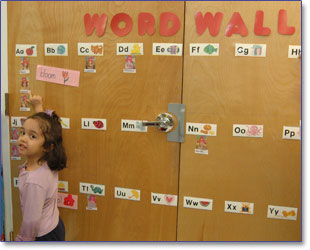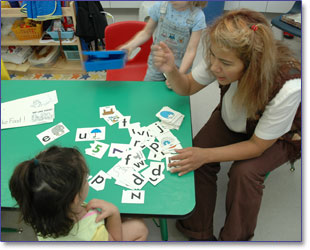  (Page 3 of 3) (Page 3 of 3)
Children Need to Know the Most Common Sound for Each Letter
 In addition to being able to recognize each letter, children need to know the most common sound each letter makes. Typically, children learn the name of a letter before they learn the sound of the letter. One reason for this is that many letter names contain the letter sound. For example, you can hear the /s/ in the name of the letter “s” and when you say the name of the letter “m” you can hear the /m/ sound. These connections between the names of letters and the sounds they make can be useful to children. Letters such as “w” or “y,” which don’t offer this kind of support, are usually some of the most difficult letter sounds to master. In addition to being able to recognize each letter, children need to know the most common sound each letter makes. Typically, children learn the name of a letter before they learn the sound of the letter. One reason for this is that many letter names contain the letter sound. For example, you can hear the /s/ in the name of the letter “s” and when you say the name of the letter “m” you can hear the /m/ sound. These connections between the names of letters and the sounds they make can be useful to children. Letters such as “w” or “y,” which don’t offer this kind of support, are usually some of the most difficult letter sounds to master.
One of the most important factors in teaching letter sounds is the way the teacher pronounces each sound. Now, let’s
think about some ways we can teach those sounds
to children. It can be helpful for many children
to have a key word to link to each letter sound.
Many alphabet charts, books, and songs link a letter
to a key word in a memorable way. It is important
that the key word for each letter reinforces the
most common sound for that letter. For example,
gum represents the most common sound for g while
giraffe does not.
A picture-word wall can also help children
connect letters and sounds. To create a picture-word
wall, make a letter card for each letter and
affix them to your wall in alphabetical order
at your children’s
eye level. Leave enough room under each letter
for no more than five additional picture-word
cards. As you focus on a letter sound, find words
that begin with that letter and can be represented
with a picture. Write the word for each picture
in large, clear, lowercase letters. Be sure to
select words that will be meaningful to your
students. Attach the picture-word cards to the
wall beneath the appropriate letters. Again,
be sure that the picture-word cards that are
added below each letter represent the most common
sound for that letter. For example, it would
make sense to add cookie
with a picture of a cookie under the letter "c."
However, city would not make
sense because the /s/ sound for "c" is
less common.
 There are many ways to help children practice
letter sounds. We talked about using alphabet
books to teach children to recognize letters.
Most alphabet books can also be used to practice
connecting letters with their sounds. Actual objects
and picture card sorts can provide another fun
way for a small group of children to practice
together. The use of objects or cards with easily
recognizable pictures enables children to decide
what sound a picture name starts with and then
find the letter that makes that sound. Begin with
just two or three different sounds to sort, and
add more as your students become proficient with
the sorting activity. There are many ways to help children practice
letter sounds. We talked about using alphabet
books to teach children to recognize letters.
Most alphabet books can also be used to practice
connecting letters with their sounds. Actual objects
and picture card sorts can provide another fun
way for a small group of children to practice
together. The use of objects or cards with easily
recognizable pictures enables children to decide
what sound a picture name starts with and then
find the letter that makes that sound. Begin with
just two or three different sounds to sort, and
add more as your students become proficient with
the sorting activity.
|